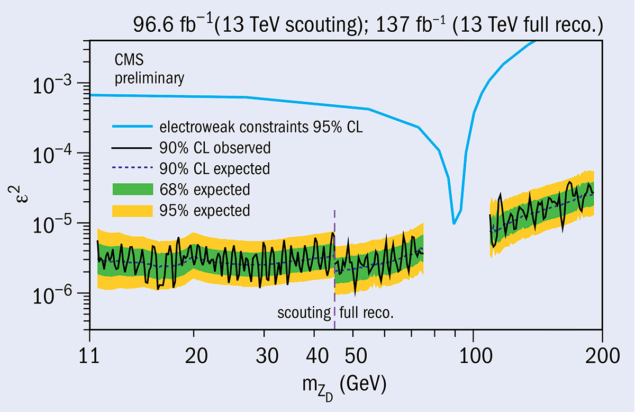A report from the CMS experiment

One of the best strategies for searching for new physics in the TeV regime is to look for the decays of new particles. The CMS collaboration has searched in the dilepton channel for particles with masses above a few hundred GeV since the start of LHC data taking. Thanks to newly developed triggers, the searches are now being extended to the more difficult lower range of masses. A promising possible addition to the Standard Model (SM) that could exist in this mass range is the dark photon (ZD). Its coupling with SM particles and production rate depend on the value of a kinetic mixing coefficient ε, and the resulting strength of the interaction of the ZD with ordinary matter may be several orders of magnitude weaker than the electroweak interaction.
The CMS collaboration has recently presented results of a search for a narrow resonance decaying to a pair of muons in the mass range from 11.5 to 200 GeV. This search looks for a strikingly sharp peak on top of a smooth dimuon mass spectrum that arises mainly from the Drell–Yan process. At masses below approximately 40 GeV, conventional triggers are the main limitation for this analysis as the thresholds on the muon transverse momenta (pT), which are applied online to reduce the rate of events saved for offline analysis, introduce a significant kinematic acceptance loss, as evident from the red curve in figure 1.

A dedicated set of high-rate dimuon “scouting” triggers, with some additional kinematic constraints on the dimuon system and significantly lower muon pT thresholds, was deployed during Run 2 to overcome this limitation. Only a minimal amount of high-level information from the online reconstruction is stored for the selected events. The reduced event size allows significantly higher trigger rates, up to two orders of magnitude higher than the standard muon triggers. The green curve in figure 1 shows the dimuon invariant mass distribution obtained from data collected with the scouting triggers. The increase in kinematic acceptance for low masses can be well appreciated.
The full data sets collected with the muon scouting and standard dimuon triggers during Run 2 are used to probe masses below 45 GeV, and between 45 and 200 GeV, respectively, excluding the mass range from 75 to 110 GeV where Z-boson production dominates. No significant resonant peaks are observed, and limits are set on ε2 at 90% confidence as a function of the ZD mass (figure 2). These are among the world’s most stringent constraints on dark photons in this mass range.
Further reading
CMS Collab. 2019 CMS-PAS-EXO-19-018.





